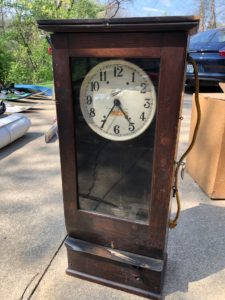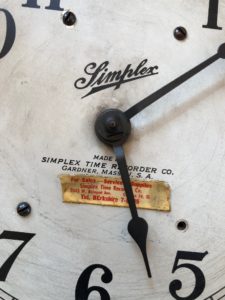 Nothing feels quite as weighty as time these days. I purloined my kitchen clock from a garage going out of business. It bears that 1970’s Bendix logo with the Bendix smile, with the statement “Automotive Parts.” Clocks are often watched, so I felt thrilled when GQ sent me a photo of a Simplex Time Clock. GQ’s family owned, and watched, this clock for as long as anyone remembers in the family business begun by his great-grandfather in 1890!
Nothing feels quite as weighty as time these days. I purloined my kitchen clock from a garage going out of business. It bears that 1970’s Bendix logo with the Bendix smile, with the statement “Automotive Parts.” Clocks are often watched, so I felt thrilled when GQ sent me a photo of a Simplex Time Clock. GQ’s family owned, and watched, this clock for as long as anyone remembers in the family business begun by his great-grandfather in 1890!
Two labels appear on the clock. One, a paper label from the last quarter of the 19th century, and a sticky label from a repair shop in Illinois in the 1950’s. So when GQ says it worked, and in the family, I believe him.
A Valuable Story
As far as “important” clocks go, GQ’s isn’t so important. A Time Clock by Simplex Time Recorder Co, Gardner, MA. But this clock shares an intimately connected with one of the largest of all corporations, the mighty IBM company. GQ’s Simplex Time recorder and punch clock tells a story of its time. In fact, GQ’s clock, from the standpoint of the study of how a material objects relates to culture tells us a ‘valuable” story.
Inside that heavy oak case lives a fully mechanized metal recording stamp engaged with the timecard in the slot activated by the lever. Simplex became known for its heavy mechanized clocks. Another model from the 1930’s featured a RCA radio built into the middle of a grandfather clock.
The interior contains a cyndrillical recorder that prints out the time on a roll of paper for the boss. GQ might have the original key, once pinned on the waistcoat of the boss to keep an employee out of the machinery of the clock.
That little image I put into your head of the boss holding the key is indicative of the way your employer ‘held’ time. Your time became HIS indeed from this invention forward. So although we don’t consider it an “important” clock in the parlance of the auction house, it does offer historically valuable.
Many Simplex time clocks still exist
 The workings are so simple that owners fixed the clocks themselves. But the very invention of a machine to ‘clock-in’ a human worker seems monumental. Humans began to be monitored by machines, fundamentally important to the growth of American enterprise at the end of the 19th century. Notice that the boss held the master key in my description above.
The workings are so simple that owners fixed the clocks themselves. But the very invention of a machine to ‘clock-in’ a human worker seems monumental. Humans began to be monitored by machines, fundamentally important to the growth of American enterprise at the end of the 19th century. Notice that the boss held the master key in my description above.
Willard LeGrand Bundy of Auburn NY invented the system for mechanized “punching in.” That’s where the phrase comes from. Each worker punched his card by turning his unique key.
Bundy and his brother Harlow formed the Bundy manufacturing company in 1889, producing time punch clocks. The clock didn’t lie or accept bribes like a human record keeper. They sold millions of these clocks. The Bundy Brothers merged with an established clockmaking company (Simplex) to manufacture these clocks. By 1900 the Bundys merged again to form the Computing-Tabulating-Recording Company (CTR), which later changed its name to IBM.
Yes, I mean THAT IBM
IBM stayed in the business of making time clocks under their Equipment Division from 1900-1958. The step from mechanical time keeping to computerization of other business machines wasn’t far. Because humans often outsmarted a machine, GQ’s clock’s basic system became obsolete in the 1950’s, and IBM moved its focus to more complex business machines..
The “Buddy Punch,” when your pal “punched in” for you!, necessitated the development in the 1970’s of a card swipe. Today we punch a “smartclock” which takes an employee’s photo with scan technology.
Weighty clocks no longer provide a usable service
 Today’s time clocks are capable of so much more oversight of the boss’s time, more, such as a biometric reader that identifies a unique feature of the employee. This requires the employee “give away” the configuration of the eye’s iris.
Today’s time clocks are capable of so much more oversight of the boss’s time, more, such as a biometric reader that identifies a unique feature of the employee. This requires the employee “give away” the configuration of the eye’s iris.
GQ, if you want to spend more than the $300 your clock is worth, you can buy a ticket to New York to visit the inventor’s home in Binghamton, a house museum dedicated to the Bundy brothers, who set the wheels in motion for the biggest company in the world responsible for ‘time computing,’ IBM.
Such a cool backstory, but you always find those Elizabeth. As I was reading the Rolling Stone’s ‘Time is on my side’ was running through my mind.
Spoken like a true Rock-n-Roller!